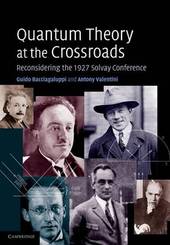
|
Quantum Theory at the Crossroads: Reconsidering the 1927 Solvay Conference
Paperback / softback
Main Details
| Title |
Quantum Theory at the Crossroads: Reconsidering the 1927 Solvay Conference
|
| Authors and Contributors |
By (author) Guido Bacciagaluppi
|
|
By (author) Antony Valentini
|
| Physical Properties |
| Format:Paperback / softback | | Pages:558 | | Dimensions(mm): Height 245,Width 170 |
|
| Category/Genre | Quantum physics |
|---|
| ISBN/Barcode |
9781107698314
|
| Classifications | Dewey:530.12 |
|---|
| Audience | | Professional & Vocational | |
|---|
|
Publishing Details |
| Publisher |
Cambridge University Press
|
| Imprint |
Cambridge University Press
|
| Publication Date |
21 November 2013 |
| Publication Country |
United Kingdom
|
Description
The 1927 Solvay conference was perhaps the most important in the history of quantum theory. Contrary to popular belief, questions of interpretation were not settled at this conference. Instead, a range of sharply conflicting views were extensively discussed, including de Broglie's pilot-wave theory (which de Broglie presented for a many-body system), Born and Heisenberg's 'quantum mechanics' (which apparently lacked wave function collapse or fundamental time evolution), and Schroedinger's wave mechanics. Today, there is no longer a dominant interpretation of quantum theory, so it is important to re-evaluate the historical sources and keep the debate open. This book contains a complete translation of the original proceedings, with essays on the three main interpretations presented, and a detailed analysis of the lectures and discussions in the light of current research. This book will be of interest to graduate students and researchers in physics and in the history and philosophy of quantum theory.
Author Biography
Guido Bacciagaluppi is a Senior Research Fellow at the Centre for Time, University of Sydney. His research interests lie mainly in the philosophy of physics. He has contributed significantly to the development and critique of modal interpretations of quantum mechanics, and he has since worked widely in various approaches to the foundations of quantum theory, as well as in the philosophy of probability and time and in the history of quantum mechanics. Antony Valentini is a Research Associate in the Theoretical Physics Group, Imperial College London. He proposed that the universe began with a non-quantum distribution of hidden variables, which later relaxed to the quantum equilibrium state we see today. He has pioneered the development of new physics of quantum nonequilibrium, de Broglie-Bohm theory, and hidden-variables theories generally, and has explored its possible role in cosmology, black holes, and information theory. He also works in the history and philosophy of modern physics.
Reviews'Considering the development of quantum mechanics, Quantum Theory at the Crossroads offers a very stimulating viewpoint as its authors take a rather polarizing stance. Overall, it provides an important and inspiring history of quantum mechanics, being most valuable for its translation of the conference proceedings and its account of de Broglie's often neglected pilot-wave theory.' Martin Jahnert, Metascience '... a most useful volume for historians and philosophers of physics alike. The excellent introduction and the important sources make [it] a most valuable contribution to the philosophy and history of quantum mechanics. It should be included in the reading list of every class on that subject, and it should be read by anyone who is concerned with the conceptual problems of quantum mechanics. I also recommend it to physicists who are looking for a good place to start reading about the historical emergence of interpretational problems of modern quantum theory.' Isis '... this book could play a role in guiding readers to the original works of de Broglie and Bohm, and ... promote a more open-minded appreciation of their contributions than is customary even now.' Contemporary Physics '... the book is already a very important contribution to our understanding of the Fifth Solvay Conference. The translation of the proceedings will make the various voices of the various participants much more accessible to a wide audience, and the historical account of how the conference came to be, how the various participants thought about and prepared their own contributions, and how the proceedings themselves were prepared will be an eye-opener for many readers. The truth about the conference is far more interesting than the fictions that are usually promulgated, and the authors do an excellent job debunking those fictions. Perhaps the lesson to learn here is that contemplating the Fifth Solvay Conference is a bit like taking a Rorschach inkblot test. The authors' own contemplation is ambitious, thought provoking, delightfully detailed, and itself deserving of further contemplation.' Michael Dickson, Philosophy of Science 'On the whole, the authors' arguments are well thought through and balanced. But in my opinion the most vital aspect of the book is that it highlights de Broglie's historical position and tries to understand why his achievements were neglected, and for this reason alone I would recommend this book.' Jan Faye, Centaurus
|